Vitamin E Lipid-Based Nanodevices as a Tool for Ovine Sperm Protection against Oxidative Stress: Impact on Sperm Motility
- PMID: 36290711
- PMCID: PMC9598640
- DOI: 10.3390/antiox11101988
Vitamin E Lipid-Based Nanodevices as a Tool for Ovine Sperm Protection against Oxidative Stress: Impact on Sperm Motility
Abstract
The advent of nanotechnology in the field of animal reproduction has led to the development of safer and more efficient therapies. The use of nanotechnology allows us to avoid the detrimental effects of certain traditional antioxidants, such as Vitamin E. Its hydrophobic nature makes mandatory the use of organic solvents, which are toxic to sperm cells. This study aims to evaluate the efficiency of vitamin E nanoemulsions (NE) on ram (Ovis aries) spermatozoa. For this purpose, the effect of three NE concentrations (6, 12, and 24 mM) were assessed on sperm of 10 mature rams of the Manchega breed. Sperm samples were collected by artificial vagina, pooled, and diluted in Bovine Gamete Medium. The samples were stored at 37 °C and assessed at 0, 4, 8, and 24 h under oxidative stress conditions (100 µM Fe2+/ascorbate). Motility (CASA), viability (YO-PRO/IP), acrosomal integrity (PNA-FITC/IP), mitochondrial membrane potential (Mitotracker Deep Red 633), lipoperoxidation (C11 BODIPY 581/591), intracellular reactive oxygen species (ROS) production and DNA status (SCSA®®) were assessed. A linear mixed-effects models were used to analyze the effects of time, NE, and oxidant (fixed factors) on sperm parameters, and a random effect on the male was also included in the model with Tukey's post hoc test. Protection of ram spermatozoa with NE resulted in a more vigorous motility under oxidative stress conditions with respect Control and Free vitamin E, while preventing the deleterious effects of oxidative stress coming from the production of free radicals and lipid peroxidation. These results ascertain the high relevance of the use of delivery systems for sperm physiology preservation in the context of assisted reproduction techniques.
Keywords: drug liberation; nanoemulsions; nanotechnology; sperm oxidative stress; vitamin e.
Conflict of interest statement
The authors declare no conflict of interest.
Figures

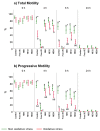
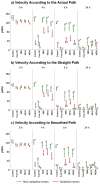
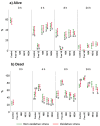


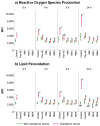
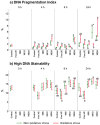
Similar articles
-
Minimizing sperm oxidative stress using nanotechnology for breeding programs in rams.J Anim Sci Biotechnol. 2023 Aug 10;14(1):106. doi: 10.1186/s40104-023-00907-3. J Anim Sci Biotechnol. 2023. PMID: 37559077 Free PMC article.
-
Determination of Ram (Ovis aries) Sperm DNA Damage Due to Oxidative Stress: 8-OHdG Immunodetection Assay vs. SCSA®.Animals (Basel). 2022 Nov 25;12(23):3286. doi: 10.3390/ani12233286. Animals (Basel). 2022. PMID: 36496807 Free PMC article.
-
Nanotechnology in reproduction: Vitamin E nanoemulsions for reducing oxidative stress in sperm cells.Free Radic Biol Med. 2020 Nov 20;160:47-56. doi: 10.1016/j.freeradbiomed.2020.07.024. Epub 2020 Aug 5. Free Radic Biol Med. 2020. PMID: 32768571
-
Vitamin E Delivery Systems Increase Resistance to Oxidative Stress in Red Deer Sperm Cells: Hydrogel and Nanoemulsion Carriers.Antioxidants (Basel). 2021 Nov 6;10(11):1780. doi: 10.3390/antiox10111780. Antioxidants (Basel). 2021. PMID: 34829650 Free PMC article.
-
Cinnamtannin B-1, a novel antioxidant for sperm in red deer.Anim Reprod Sci. 2018 Aug;195:44-52. doi: 10.1016/j.anireprosci.2018.05.004. Epub 2018 Jun 30. Anim Reprod Sci. 2018. PMID: 29776697
Cited by
-
Minimizing sperm oxidative stress using nanotechnology for breeding programs in rams.J Anim Sci Biotechnol. 2023 Aug 10;14(1):106. doi: 10.1186/s40104-023-00907-3. J Anim Sci Biotechnol. 2023. PMID: 37559077 Free PMC article.
-
Oxidative Damage Under Microgravity Conditions: Response Mechanisms, Monitoring Methods and Countermeasures on Somatic and Germ Cells.Int J Mol Sci. 2025 May 10;26(10):4583. doi: 10.3390/ijms26104583. Int J Mol Sci. 2025. PMID: 40429729 Free PMC article. Review.
-
Oxidative Stress-Associated Male Infertility: Current Diagnostic and Therapeutic Approaches.Medicina (Kaunas). 2024 Jun 20;60(6):1008. doi: 10.3390/medicina60061008. Medicina (Kaunas). 2024. PMID: 38929625 Free PMC article. Review.
-
New Delivery Systems on Sperm Quality Improvement.Methods Mol Biol. 2025;2897:207-218. doi: 10.1007/978-1-0716-4406-5_15. Methods Mol Biol. 2025. PMID: 40202638
-
Determination of Ram (Ovis aries) Sperm DNA Damage Due to Oxidative Stress: 8-OHdG Immunodetection Assay vs. SCSA®.Animals (Basel). 2022 Nov 25;12(23):3286. doi: 10.3390/ani12233286. Animals (Basel). 2022. PMID: 36496807 Free PMC article.
References
-
- Nascimento J.M., Shi L.Z., Tam J., Chandsawangbhuwana C., Durrant B., Botvinick E.L., Berns M.W. Comparison of glycolysis and oxidative phosphorylation as energy sources for mammalian sperm motility, using the combination of fluorescence imaging, laser tweezers, and real-time automated tracking and trapping. J. Cell. Physiol. 2008;217:745–751. doi: 10.1002/jcp.21549. - DOI - PMC - PubMed
Grants and funding
LinkOut - more resources
Full Text Sources

